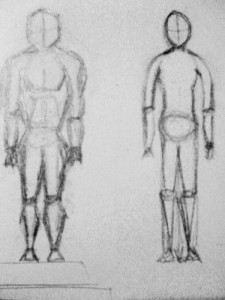by Annie | Aug 6, 2010 | Game Design
As part of the VFS admissions process for game design, I had to come up with a single game idea and create a one-page pitch. Since classes have started, however, it’s been a completely different ballgame. As musicians know, it takes countless hours of practice to become a great musician. Likewise, in order to become a great game designer, you must constantly create new game ideas. Over the past five weeks, I’ve been tasked with creating so many game ideas that I’ve lost count. Some I created on my own, most were created with partners or teams, and all came with certain purposes and restrictions. Some ideas have taken weeks to develop, while others had to be crafted within mere minutes. According to Malcolm Gladwell, it takes 10,000 hours of practice to become a master at something. At our current pace, we’ll likely surpass the creation of 10,000 game ideas before the year comes to an end. Whether or not that makes us great game designers, time will have to tell. Now, on to that next game...
by Annie | Aug 5, 2010 | Other
As term 1 is starting to come to a close, we have several projects out on the table, from presentations and exams to level designs and drawings. One project we have coming up in less than two weeks is for our visual storytelling class. The name of the class gives away the main focus: telling stories through images. Our visual storytelling final project involves a short movie using anywhere from 50 to 300 images, preferably set to music. After an initial storyboard and lots of time spent crafting pieces from construction paper and pipe cleaners, I finally snapped the necessary photos and have moved into the editing stage. Here’s a preview of the first minute (a very rough cut in low quality) for your viewing...

by Annie | Aug 4, 2010 | Illustration Station
People are hard. Hard to read and hard to draw. As far back as I can remember, I’ve had trouble drawing people. One minor line askew, and everything goes awry. In our storyboarding class, we got a quick 101 on figure drawing, which instantly demystified the whole process. Drawing people is just like simple sculpture. Start with a basic frame, then build arms, legs, muscles, and clothes on top. I still need tons of practice, but here’s a quick peek into my sketchbook from the few figures I sketched this...
by Annie | Aug 2, 2010 | Game Design
Since the field of game design is still in its infancy stage, things change fast and often. Games were once created by small teams of people with a passion for gaming but no formal training. Now, more and more, game designers, programmers, and artists are entering the field with years of schooling and experience. Soon, students will have access to game design training as early as middle school. Baltimore County Public Schools (BCPS) just announced plans to incorporate video game development education into its curriculum. To prepare teachers for the program, BCPS will implement a series of “gamification boot camps” to educate teachers on the technology behind video games. This technique of incorporating game technology with STEM (science, technology, engineering, and mathematics) is quickly catching on, increasing student engagement and interest in core subject areas. Be The Game, a game design training curriculum for high school students, was developed by the Institute of Urban Game Design in 2005 and has rapidly spread from its original school in Washington, DC, to six schools across the US. This new trend may be yet another game changer for the field of game design. As access to training becomes more prevalent, more indie games created by younger designers will soon hit the market. We may not have highly effective educational games just yet, but we do have highly motivated students ready to create them. Let the games...

by Annie | Aug 1, 2010 | Game Design
As a teacher, I wore many hats every day. Teaching aside, I regularly took on the roles of nurse, psychologist, event planner, secretary, statistician, and fellow kid. Being able to wear many hats is also one of the reasons I love studying game design. As a game designer, I must juggle the demands of budget and schedule with the creative elements of cinematography, storyline, and character and level design. I am by no means an expert, but as you may well know, I always welcome a challenge. This past Friday, I finally went to see the movie Inception. Though it was the third Friday since the movie’s release, the theater was still packed. I won’t spoil the movie for those of you who haven’t yet experienced its intense storyline, but suffice it to say that the movie has a lot in common with game design. Inception explores the possibilities of the human mind, and, in particular, of its dreams. Like game environments, dream worlds must be carefully architected. Though pieces of the dream or game may come from real life inspiration, the ultimate dream or game world is a conglomeration of the best parts of the real world. This weekend, I took on the role of a level designer. Well, kind of. My assignment was to analyze an existing game level and create a level map detailing the environment and obstacles. Sounds simple enough, right? Well, keep in mind that you have to know the level well enough to draw the map (i.e. you have to play the level over and over again). Then, you have to draw the level...


